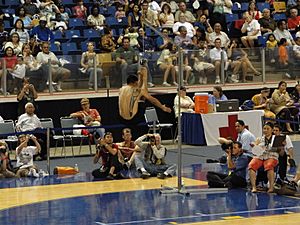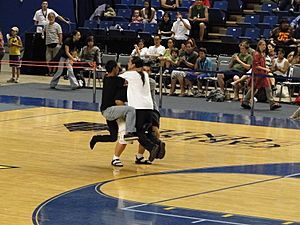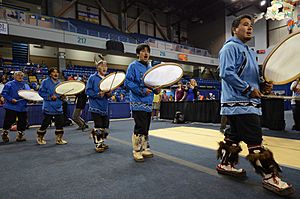Arctic sports facts for kids
Arctic sports or Inuit games (in Iñupiaq: anaktaqtuat) are a collection of exciting sports played in the cold northern parts of the world. These games are especially popular among the indigenous peoples who live there, like the Inuit. You'll find Arctic sports played in places like Yamal, Alaska, Greenland, and parts of Canada. Some of these sports are like track and field events, testing how strong, fast, or agile you are. Others are more like martial arts or gymnastics.
In Canada, sports played by the First Nations are often called Dene games. Traditional Greenlandic sports are known as Kalaallit Pinnguaataat. These sports are played at a high level in big events like the Arctic Winter Games, the World Eskimo Indian Olympics, and the Native Youth Olympics in Alaska.
Contents
- History of Arctic Sports
- Awesome Arctic Sport Disciplines
- One Foot High Kick
- Two Foot High Kick
- Alaskan High Kick
- One Hand Reach
- Kneel Jump
- Triple Jump
- Scissor Broad Jump
- Sledge Jump
- Knuckle Hop
- Seal Hop
- Airplane
- Arm Pull
- Head Pull
- Ear Pull
- Finger Pull
- Dene Stick Pull
- Inuit Stick Pull
- Snow Snake
- Pole Push
- Hand Games
- Wrist Carry
- Four Man Carry
- Ear Weight
- Greased Pole Walk
- Bench Reach
- Blanket Toss
- Major Arctic Sports Competitions
- See Also
History of Arctic Sports
Most Arctic sports began from the way people lived long ago, especially from hunting and fishing. In the Arctic, hunting and fishing were super important for survival. So, training for these skills was vital! People developed many ways to train their strength, endurance, and agility.
Some Arctic sports also came from everyday camp life and just having fun. They were a way for tribes to entertain themselves. Over time, these training methods and fun activities became official sports. People would often compete in friendly games between different tribes and communities.
Things changed a lot when the World Eskimo Indian Olympics started in 1961 and the Arctic Winter Games began in 1970. These events helped turn these traditional games into more organized and professional sports.
Awesome Arctic Sport Disciplines
One Foot High Kick
The one foot high kick came from Inuit hunting. Hunters would use a high kick to signal a successful hunt from far away. In this sport, an athlete jumps with both feet and tries to kick a target hanging in the air with just one foot. Then, they must land on that same kicking foot without falling over. In competitions, the target gets raised higher and higher. The person who kicks the highest wins!
This kick is a big event at the Arctic Winter Games. Athletes get three tries at each height. If they miss three times, they're out! They can even take a running start. The highest recorded one foot high kick was 2.92 meters (9 feet 7 inches) by Stuart Towarak in 2018.
Two Foot High Kick
In the two foot high kick, the athlete jumps with both feet close together. They try to hit a hanging target with both feet at the same time. After kicking, they must land on both feet without losing their balance.
The highest two foot high kick ever recorded was 2.64 meters (8 feet 8 inches). Brian Randazzo set this record in 1988.
Alaskan High Kick
For the Alaskan high kick, the athlete sits on the floor. They balance on one foot and hold their other foot with one hand. Their free hand is placed on the floor for support. Then, the athlete jumps up, balancing only on their hand, and tries to hit a hanging target. They must land on the kicking foot without falling.
Jesse Frankson holds the record for the Alaskan high kick at 2.39 meters (7 feet 10 inches), set in 2002.
One Hand Reach
In the one hand reach, the athlete balances on one hand, keeping their elbow tucked close to their body. While balancing, they reach up to hit a hanging target. After hitting it, their striking hand must be the first part of their body to touch the ground.
The world record for one hand reach is 1.78 meters (70 inches), set by Bernard Clark in 2015.
Kneel Jump
The kneel jump has roots in Inuit hunting culture. Some say it was a way for hunters to quickly escape from predators or breaking ice. Others believe it helped strengthen legs for jumping between ice floes. To do a kneel jump, the athlete starts on their knees with hands on their lap. From this kneeling spot, they jump up and forward as far as they can. They must land on their feet without losing balance, and their feet must be within shoulder width apart.
Dylan Magnusen set the world record in kneel jump in 2013, jumping 1.72 meters (5 feet 7 inches).
Triple Jump
The Arctic triple jump is a version of the classic track and field triple jump. In this sport, the athlete jumps forward as far as possible. Their feet must stay within shoulder width apart. They then jump two more times, always keeping their feet within shoulder width apart.
Drew Bell holds the record for the longest Arctic triple jump at 11.49 meters, set in 2016.
Scissor Broad Jump
The scissor broad jump is similar to the triple jump, but with a twist! The athlete jumps four times. After each jump, they cross and uncross their legs in the air. All jumps must be done without losing balance.
Nick Hanson set the world record in scissor broad jump in 2016, with a distance of 11.4 meters (37 feet 5 inches).
Sledge Jump
In the sledge jump, athletes jump over ten sledges, one after another. After clearing all ten, they get a short rest (5-10 seconds). Then, they turn around and jump back over the sledges. The athlete keeps going until they knock over or hit a sledge.
The record for sledge jump is an amazing 830 jumps, set by Rodin Roaldovich Taligin in 2006!
Knuckle Hop
For the knuckle hop, the athlete gets into a pushup position, but on their fists and toes. Then, they jump forward in this position, making sure their body stays off the floor the whole time.
Chris Stipdonk holds the knuckle hop world record, covering 61.2 meters (200 feet 8 inches) in 2020.
Seal Hop
The seal hop is like the knuckle hop, but the athlete is on their palms and toes. They jump forward in the same way. This sport came from hunting, where hunters would do seal hops to sneak up on seals.
SigFurd Dock holds the seal hop record, with 57.3 meters (188 feet), set in 2015.
Airplane
In the airplane discipline, the athlete lies face down on the floor with their arms stretched out. Three helpers lift the athlete and carry them forward. The athlete must stay in that outstretched position. If they can't, their turn ends. This sport is also called "drop the bomb."
At the Arctic Winter Games, this sport used to be measured by distance. The record for longest distance was 48.98 meters (160 feet 8.5 inches) by Makabe Nartok in 1986. In 2016, it changed to a timed event. The record for longest time is 46.69 seconds, set by Tittu Wille in 2016.
Arm Pull
In arm pull, two athletes sit on the floor facing each other. They lock their arms at the elbows. Each person holds their opponent's right ankle with their left hand. Their left leg is straight, and their right leg is hooked over their opponent's left leg, locking them together. The goal is to pull your opponent over or make them touch their hand to their own chest.
Head Pull
For head pull, two athletes lie on the floor facing each other. A soft leather belt is placed over the back of each athlete's head. They get into a pushup position and then start pulling with their heads. The goal is to pull your opponent across a line on the ground.
Ear Pull
In ear pull, two athletes sit on the floor facing each other. A looped string is placed around one ear of each athlete. They pull straight back, trying to pull the string off their opponent's ear.
Finger Pull
For finger pull, two athletes lock their middle fingers together. They try to pull their opponent's arm forward or make them break their finger lock. This sport came from fishing. Strong fingers were needed to carry many fish, as fish were often carried by hooking fingers through their gills. Finger pull was a great way to make fingers stronger.
Dene Stick Pull
Dene stick pull is a traditional sport of the Dene people. Two athletes hold onto a stick that is completely covered in grease. They try to pull the stick away from their opponent. Like many Arctic sports, it came from ice fishing. The greasy stick tests an athlete's grip, just like holding a slippery fish. Dene fishermen would practice stick pull to improve their grip for catching fish bare-handed. Traditionally, bear grease was used, but today, regular grease is common in competitions.
Inuit Stick Pull
The Inuit stick pull (or Eskimo stick pull) is similar to the Dene stick pull, but the stick is not greased. Athletes hold the stick with both hands. One athlete holds the center, and the other holds the sides. The goal is to pull your opponent over or make them lose their grip on the stick.
Snow Snake
The snow snake sport comes from the Iroquois and Dene people. In this game, an athlete throws a carved stick along a special path. This sport also came from hunting. Throwing the snow snake is like hunting caribou, seals, or ptarmigan. Hunters had to sneak up on their prey and throw their spear or snow snake from far away with great aim.
Sandy Annanack set the longest recorded distance in a snow snake game in 2008, throwing it 159.89 meters (524 feet 7 inches).
Pole Push
Pole push is like a tug-of-war game. Teams of athletes hold onto a pole and try to push the other team across a marked line. This sport came from general camp life in the Arctic. It was a way to train strength and have fun. The Dene people used it as strength training to prepare for carrying heavy wooden canoes over long distances.
Hand Games
In hand games, two teams kneel on the floor facing each other. Teams take turns being the "active" team. The active team hides tokens in their hands under a blanket. Drummers and singers often play music while the tokens are being hidden. After the tokens are hidden, the other team has to guess which hands hold the tokens.
Wrist Carry
For the wrist carry, an athlete hooks one wrist over the center of a pole. Two helpers then carry the pole. The athlete must stay hanging from the pole while being carried along a set path.
Four Man Carry
The four man carry came from hunting. It was a way to train for carrying large animals after a successful hunt. In this sport, the athlete carries four volunteers as far as possible.
Ear Weight
The ear weight sport involves athletes attaching loops of string around one ear, with a lead weight tied to the other end. The athlete then tries to move as far as possible along a path. Their turn ends if the weight drops or if a judge sees them not lifting correctly. Long ago, this sport helped people train to endure the pain of frostbite, using sacks of flour instead of lead weights.
Greased Pole Walk
Greased pole walk involves athletes walking across a greasy pole. The goal is to go the farthest distance down the pole. This sport came from scavenging, where people needed good balance to cross slippery logs over creeks and rivers.
Bench Reach
For the bench reach, the athlete kneels at the edge of a bench. They lean forward, and a helper sits on their lower legs to keep them in place. The athlete then leans forward and tries to place an object as far away as possible.
Blanket Toss
The blanket toss, also known as Nalukataq, is like a trampolining sport. The "trampoline" is made from walrus hide or a seal skin blanket, held by 40 to 50 volunteers. The goal is to get as high as possible while also showing good balance and style in the air. The blanket toss comes from the Nalukataq celebration, where it has always been a very important part of the festivities.
Major Arctic Sports Competitions
Arctic Winter Games
The first Arctic Winter Games happened in 1970. Arctic sports were just for show then, but they became official medal events in 1974. Six disciplines were included: kneel jump, two foot high kick, one foot high kick, one hand reach, back bend, and rope gymnastics. Since 1974, Arctic sports have been a part of every Arctic Winter Games, and more sports have been added over the years. Today, there are 11 Arctic sports disciplines and an all-around competition, with 35 medal events!
Dene games also became a sport at the Arctic Winter Games in 1990. They were first grouped with Arctic sports. In 1998, Dene games became their own separate sport and have been featured ever since.
Some of the Arctic sports you'll see at the modern Arctic Winter Games are one foot high kick, two foot high kick, Alaskan high kick, kneel jump, airplane, one hand reach, head pull, knuckle hop, sledge jump, triple jump, and arm pull. The Dene games include finger pull, hand games, snow snake, stick pull, and pole push.
World Eskimo Indian Olympics
The World Eskimo Indian Olympics focuses only on Arctic and native sports. The first games were held in Fairbanks, Alaska, in 1961. Back then, there were only three sports: high kick, blanket toss, and seal skinning, along with cultural events. Now, these games feature about twenty different sports! The games were first called the World Eskimo Olympics, but the name changed in 1973 to better include all the different native groups who participated.
Nunatsinni Unammersuarneq
Nunatsinni Unammersuarneq is the championship for Arctic sports in Greenland. Arctic Sports Greenland organizes this competition. It's a big deal in Greenland, with the events often broadcast live on TV and radio by KNR. Sports played here include the three high kick disciplines (Alaskan, two foot, and one foot), kneel jump, triple jump, one hand reach, and a special traditional Greenlandic high kick called "angakkuusaarneq."
Native Youth Olympics
The Native Youth Olympics (also known as the NYO Games) started in 1972. It's a local competition for Arctic and native sports held in Alaska.
See Also
- Arctic Winter Games
- World Eskimo Indian Olympics








